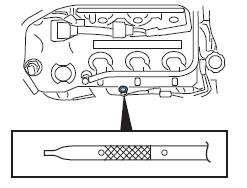Checking the engine oil

Refer to the scheduled maintenance information for the appropriate intervals for checking the engine oil.
1. Make sure the vehicle is on level ground.
2. Turn the engine off and wait 15 minutes for the oil to drain into the
oil pan.
3. Set the parking brake and ensure the gearshift is securely latched in P
(Park).
4. Open the hood. Protect yourself from engine heat.
5. Locate and carefully remove the
engine oil level dipstick.

6. Wipe the dipstick clean. Insert the dipstick fully, then remove it again.
Х If the oil level is within this range, the oil level is acceptable.
DO NOT ADD OIL.

Х If the oil level is below this mark, engine oil must be added to raise the level within the normal operating range.

Х If required, add engine oil to the engine. Refer to Adding engine oil
in this chapter.
Х Do not overfill the engine
with oil. Oil levels above this
mark may cause engine
damage. If the engine is
overfilled, some oil must be
removed from the engine by an
authorized dealer.
7. Put the dipstick back in and ensure it is fully seated.

See also:
Congratulations
Congratulations on acquiring your new Lincoln. Please take the time to
get well acquainted with your vehicle by reading this handbook. The
more you know and understand about your vehicle, the grea ...
Wheel lug nut torque specifications
Retighten the lug nuts to the specified torque within 100 miles (160 km)
after any wheel disturbance (rotation, flat tire, wheel removal, etc.).
WARNING: When a wheel is installed, always remove ...
Connecting the jumper cables
Note: In the illustration, the vehicle on the bottom is used to
designate
the assisting (boosting) battery.
1. Connect the positive (+) jumper
cable to the positive (+) terminal of
the disc ...
